January in the dunes of Calais. It would be a euphemism to say the climate is harsh. It is cold, damp and very windy, infrastructure is scarce and there are real health problems. As the first freezes and snowfalls of winter arrive, everyone is bound to feel reassured in the knowledge that the refugees in Calais, who have been waiting on our inhospitable soil for a chance to reach England, will finally have a warm place to sleep.
But that is not actually the case.

Enlargement : Illustration 1

So far only a few dozen people have agreed to move into the containers. "My shack is quite comfortable," one of the people living in the Calais 'Jungle' told daily newspaper Libération. In fact the refugees, who fear being forced to seek asylum in France, see the container camp as a form of incarceration. And it must be said that the people behind the project appear to have deliberately chosen an aesthetic arrangement and security procedures that are worrying at best.
AN ENCLOSURE WITH VIDEO SURVEILLANCE AND BIOMETRIC ACCESS
The container camp is surrounded by a wire fence and has video surveillance and biometric access. Politicians continually proclaim in all possible ways that gaining access to the camp will not require giving fingerprints. So what exactly is going on?
The camp is financed by public money. Yet I have not been able to find anywhere a budget accounting for the 20 million euros announced for funding it, nor any references to the suppliers. There is, however, a photo of the device for gaining access to the camp in an article in local regional daily La Voix du Nord. But given that there is no source or caption with the picture, it would have to be checked against the actual device.
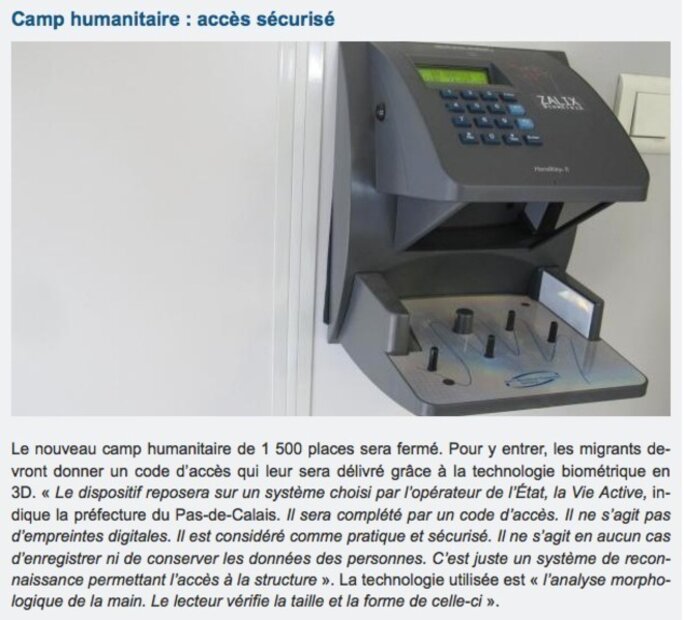
Enlargement : Illustration 2

Several French companies can make this type of "biometric reader with palm recognition", such as Synchonic or AX'IOM, for example. The model shown in La Voix du Nord is from Zalix Biométrie, a subsidiary of casino operator Groupe Tranchant. It claims on its web site to be the "precursor and indisputable reference in the biometric field".
Given the size of the container camp, one could imagine that the models used there would be similar to the ZX-HP 3000, which is described in detail on the company's site. This description accords with what politicians and associations describe when they talk about how access to the Calais container camp is controlled – morphological hand recognition associated with an individual code. The founder of Zalix Biométrie demonstrates the model in a promotional video dating from 2011 in which he talks about a system of "biometrics without a trace" and shows how it works.
Politicians pass the buck for the choice of means of access onto the association La Vie Active, which is managing setting up the camp. The sole argument put forward in favour of this system of access is that it is supposed to be practical.
In any case, access to the container camp is certainly biometric, and the refugees, who need to avoid being identified on French soil if they are to have a chance of reaching England, can legitimately worry about their hands becoming "a biometric key (300-character chain), resulting from processing of measurements in a specialised algorithm which is associated with the person's code", as described on Zalix's site.
CONTAINER FIRM'S BOSS WORKED IN MILITARY INTELLIGENCE
The company that was awarded the contract for manufacturing the containers, Logistic Solutions, is based in Grand Fougeray in Brittany. It may vaunt having "a very wide range" of logistical solutions for containers and a variety of formulas of Life Camp, but it nevertheless has some rather particular specialities.
According to the Journal de Vitré, the local newspaper in that corner of north-western France, the company's biggest ever contractwas a 30-million-euro deal signed in autumn 2014 under which it worked with Sodexho’s defence unit to build a Life Camp on Muroroa Atoll for the French defence ministry.
In June 2015 the blog Lignes de Défense reported on the inauguration of the Telsite 2 Life Camp there, a military site linked with France's nuclear tests in French Polynesia. The camp's role is to survey the fault lines on the atoll. La Dépêche de Tahiti newspaper called it "a charm operation by the government aimed at French Polynesia, even as the cases on compensating victims of illnesses induced by radioactivity stagnate in Paris and, at the French Polynesian Assembly, a bill aiming to end customs exonerations for the Army is delayed".
So, a few months before it became the contractor for a so-called humanitarian camp for refugees in Calais, was carrying out a major military contract. The containers it sent to Muroroa were certainly more comfortable than those destined for Calais.

Enlargement : Illustration 3
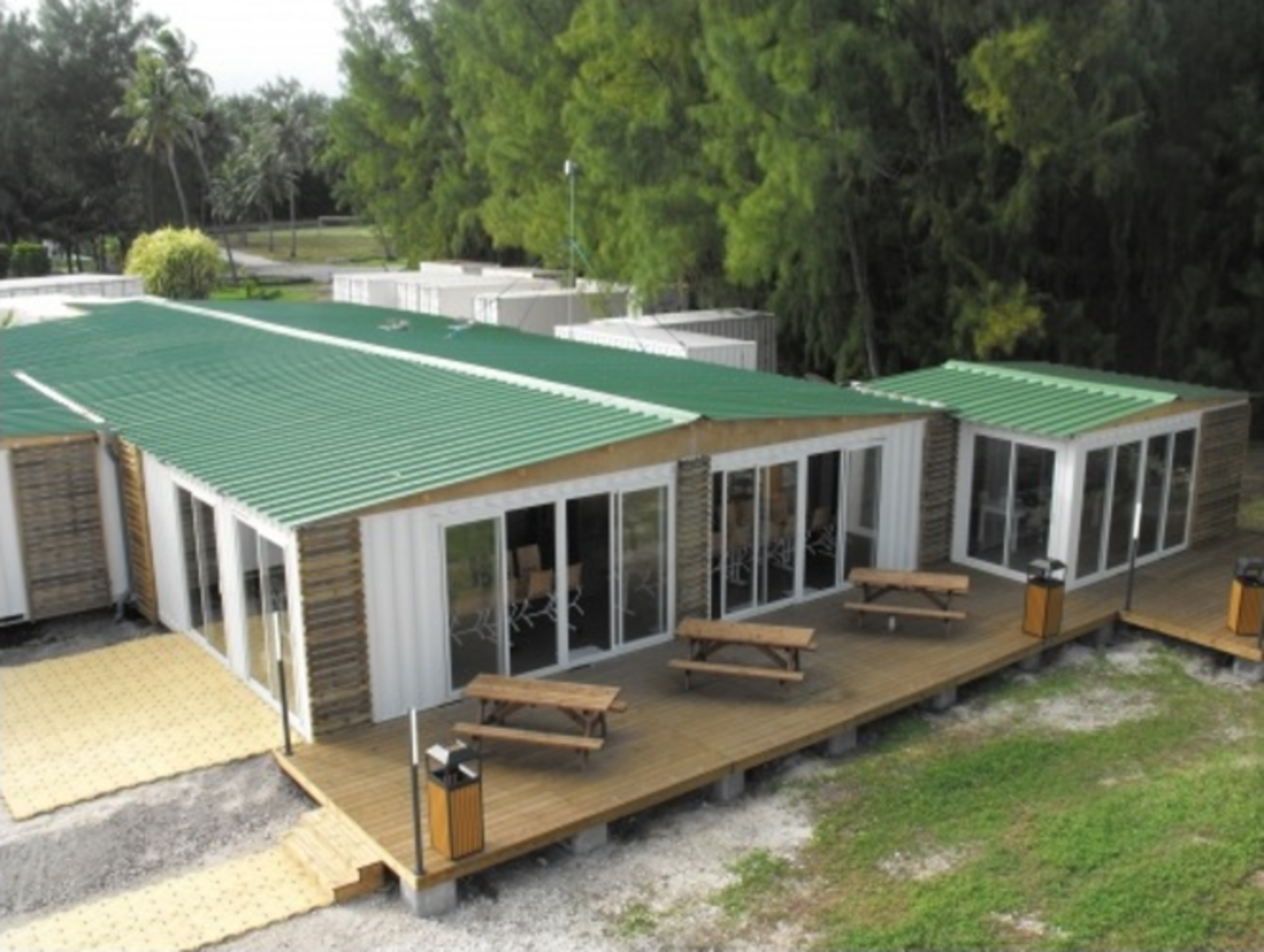
The deal with the army is not surprising, because Norbert Janvier, the director of Logistic Solutions, worked for the Direction du Renseignement Militaire (DRM, French military intelligence) until 2006, according to regional daily Ouest France. His career is detailed on Viadeo: he has been France's deputy defence attaché in Ankara, a Middle East specialist at the Defence Ministry, defence attaché in Teheran, was posted to the French Embassy in Washington and then became director of SARL Logistic Solutions.
And so, the "humanitarian" camp without any water, showers or kitchens will be encircled by an enclosure, will have video surveillance and biometric access, and is built by a company whose boss used to work in military intelligence. How curious that people don't want to go and live in those containers.
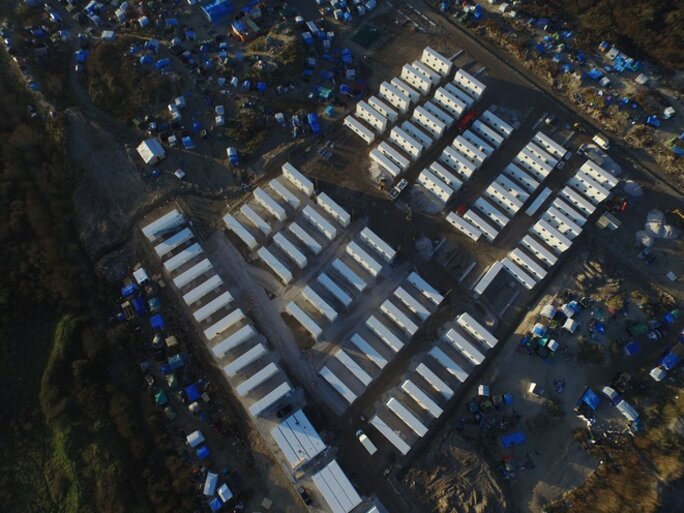
Enlargement : Illustration 4

NO WATER OR FACILITIES, BUT THERE IS ELECTRICITY
The containers are supplied with electricity, but that is about all. It is the least they could do, given that the camp is just a few kilometres from the Gravelines nuclear power plant with its six reactors.

Enlargement : Illustration 5

JUST ONE SQUARE METRE PER PERSON
There will be 12 people in a container of 14 square metres, which comes to 1.16 m2 per person. Multiply that by 125 containers and you see the camp will have a very high population density. In other words, the refugees will be sleeping practically on top of each other.
Architect Cyrille Hanappe wrote this about the camp in an opinion piece in Libération under the title À Calais, un camp des années 30 ('A camp from the 1930s in Calais'): "We have become aware of the plan for the camp commissioned by the government, which it will implement in the next few days. The plan is worse than anything we could have feared. A locked camp with 74 containers [Editor's note: the number is now 125] in rows and aligned in an orientation that goes against common sense, as bad for the sun as for the wind."
"The inhabitants will not see the sun in winter and the 'streets' are aligned in the direction of the dominant winds. They run south-west and are less than three metres wide. There is no connection to a water supply […] In Calais itself, more than 500 shacks have been built [self-built], mostly well built, waterproof and insulated and above all, taken over by their inhabitants. They are on a modular basis, and it is possible to find orientations that are much more favourable to quality of life. Architects have been working on this for decades."
Writing last October, he added: "[Prime Minister] Manuel Valls last week inaugurated the memorial at the former Rivesaltes camp in south-west France, which housed Spanish refugees, Jews, Gypsies and Harkis [Algerians who fought for France in the Algerian War]. Yet, although its concentration camp-like aspect is currently denounced, in Calais we are preparing to build something with an even worse architectural form."
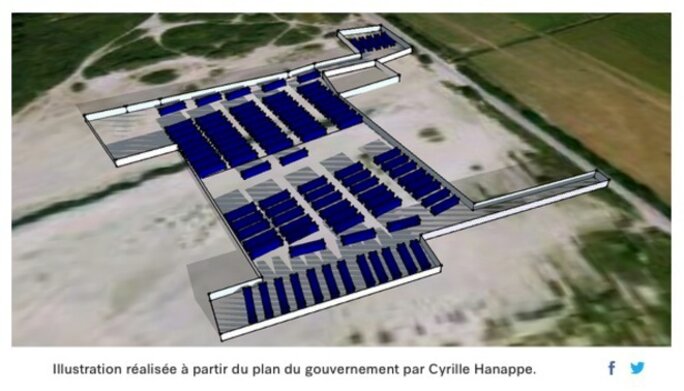
Enlargement : Illustration 6

Like a concentration camp. I would not have dared to use the words. Yet it is certainly one of the first thoughts that came to me when I discovered the plan for the camp and the concentration of population it provides for.
And I wondered: containers, to put them on a boat? Containers of 14 m2 for 12 people, as if the refugees were merchandise? Containers, like the ones in which those same refugees die in a crush trying to take sea routes?
Rows of containers surrounded by a wire fence where 1,500 people live with hardly more than a square metre of space on the ground. All you would have to do to recreate Rivesaltes in Calais would be to add barbed wire above the fence that is already there and to lock the entrance and the access system, also already in place. It would take about two hours.
And I also said to myself: We aren't there yet. Or are we?
LOCKED UP, DISPERSED, DISPLACED – BUT WHERE TO?
For besides the published, and worthy, aim to house 1,500 people "with priority" in dry, warm conditions, the building of the camp corresponds to an overtly repressive political logic.
It would be too long to revisit here the entire history of the 'Jungle', which Mediapart regularly reports upon. Let us simply remember that the inhabitants of this zone have for several months endured a two-pronged strategy, consisting of, simultaneously:
Locking up refugees, that is, placing them in detention centres far from Calais.
Dispersing the refugees, that is, sending them all over France in holding centres designed for short stays, far from anywhere and reducing to nothing their hopes of reaching England (see The controversial new strategy to draw migrants out of calais 'jungle' .
The container camp is part of this strategy. To build it, the huts and tents sheltering about 500 people in a large area at the centre of ‘the Jungle’ were destroyed. The people they housed were placed under provisional officially-provided tents and were labeled as the priority group to occupy the containers. But the state does not intend to stop there. For some days the police have been threatening to send in bulldozers to another zone where about 1,000 people are present (see Calais 'Jungle' residents defy bulldozers as police issue ultimatum to leave).
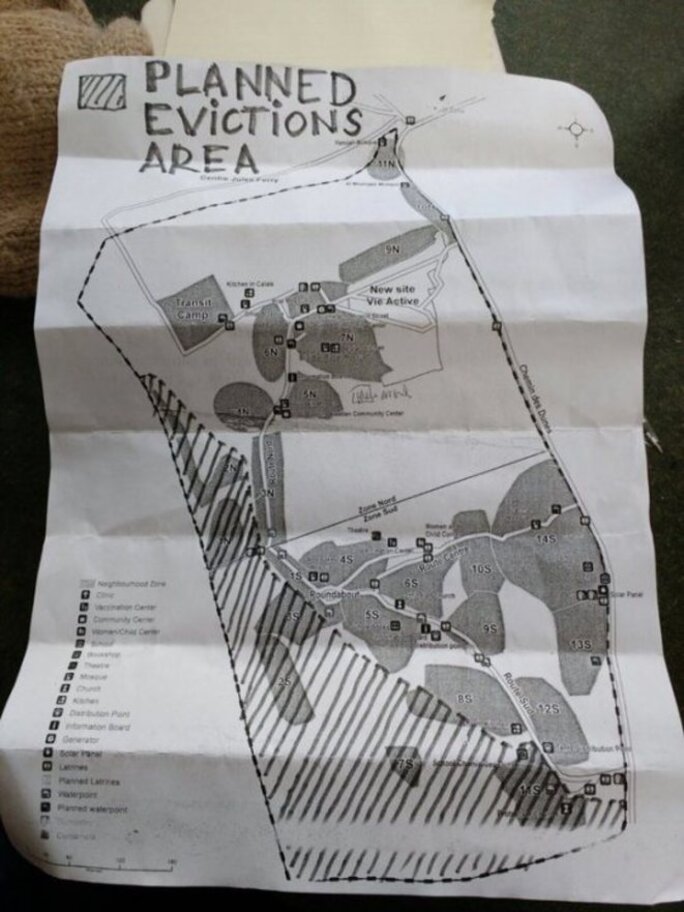
Enlargement : Illustration 7

The ultimate aim is to raze the ‘the Jungle’ as it still mostly exists and replace it entirely with a container camp. That was not said at the beginning, but the message is more and more clear. As an example, local regional daily La Voix du Nord earlier this month ran an article headlined “Calais: after the opening of the humanitarian camp the prefecture will not tolerate more than 2,000 migrants”.
In the text of the article, the prefect, Fabienne Buccio, was more guarded. “Ideally, and the path is still a long one, our objective is that Calais does not exceed 2,000 places,” she said. Knowing that, notwithstanding the under-estimates of the prefecture, about 6,000 people currently live in the zone, one asks the question is, along with organisation Calais Migrant Solidarity, What about everybody else?
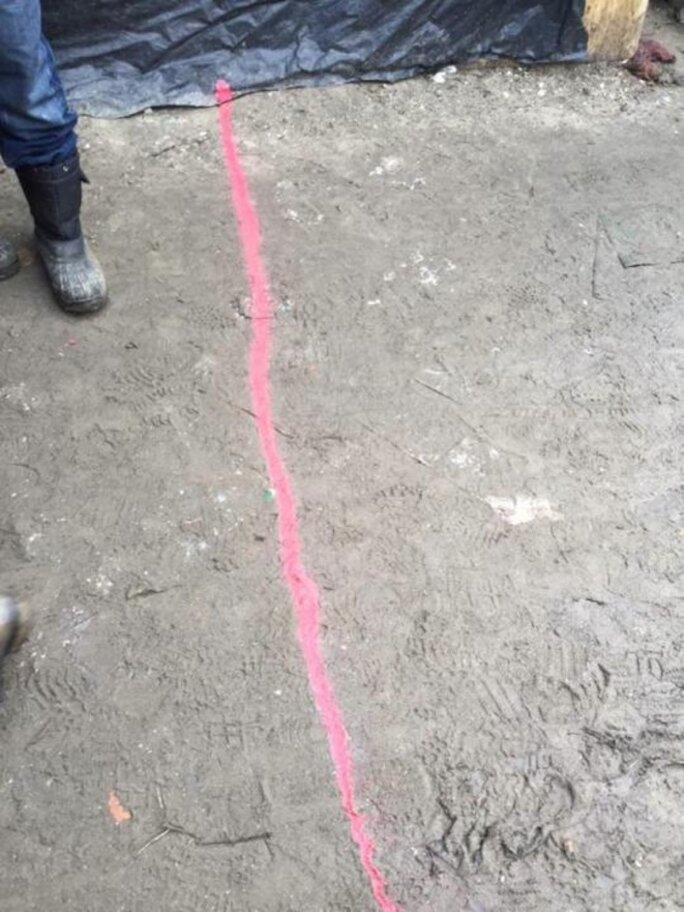
Enlargement : Illustration 8

“HUMANITY IS NOT POSSIBLE”
In the very short term, with this container camp, there is also the intention of distancing the movements of solidarity with the migrants. These, in parallel and in a complimentary manner to the institutional work carried out by the association La Vie Active, support the refugees on a daily basis by helping them with auto-construction, including building schools, discussion areas, places of prayer, holding assemblies, musical meetings, photographic exhibitions. For as long as collectives like the Calais Migrant Solidarity are in place and daily report on the situation within ‘the Jungle’ it is difficult to overtly refugees by coldly applying a distinction between those who are ‘good’ (who want to apply for asylum in France and who most often will see their applications turned down before they are deported) and those who ar ‘bad’ (who are supposedly present just to take undue economic advantage and who can be directly deported).
Last week, on her Mediapart Club blog page, Florence Prudhomme, cofounder of the movement Solidarité Calais, wrote:
"On Monday January 11th, only just set up, the state’s container camp was given significant media coverage. However, the candidates don’t appear to be in a rush for these sheet-metal barracks, lined up in military style, with tiny windows, cramped and with no comfort, without showers or washbasins, with bunk beds, like in a prison…The camp of the state is surrounded by wire fencing and guard dogs. It is accessible at night on a person’s presentation of the palm of their hand."
"The Friday before, the refugees learnt from the associations, which sere themselves informed by the prefect, that a space of 100 metres had to be cleared around 'the Jungle' and that it was necessary to take out the shelters, huts and tents which were on it. This measure concerns at least 1,000 people. This illegal destruction was preceded by no legal expulsion order…Those who have already lost everything, where do they go?"
The process of battling with the associations already began several months ago, with the violent evictions of several squats that had been set up inside Calais itself. While the evictions gave satisfaction for a certain number of the town’s inhabitants, they contributed to a worsening of the situation in ‘the Jungle’ by marginalizing the refugees even further and increasing the numbers of people living in precarious conditions on the site.
Now, with the state of emergency clamped over France, tongues are wagging without restraint and repressive political projects loom. According to local paper Nord Littoral, the conservative mayor of Calais, Natacha Bouchart, reportedly last month spoke of how “the parasites must be removed from the moor”. Which parasites? The paper did not make that clear. The mayor targeted the people smugglers, the activists helping the migrants and No Border. “I am in favour of humanity and firmness,” she said. “But with these people, humanity isn’t possible. The people smugglers, the activists, No Border, do a disservice to the migrants’ cause.”
Humanity, then, is not possible. That is where we are.
TWENTY MILLION EUROS AND STILL NO WATER
The budget announced for the creation of the camp, including its construction and the operating costs, is about 20 million euros. That means that each container costs 160,000 and, to follow the arithmetics to the logical end, an investment of more than 13,000 euros per migrant. With that money, could not a different solution have been found to that of this holding camp?
When you know that a brand new container costs 4,000 euros , and that those used in the camp are recycled second-hand ones, which are maybe worth 2,000 euros, the question is raised whether public money is being properly used. Yes there are a few new local jobs created, but how can one understand that with a budget of that size there was no provision made to connect the containers with a water supply or to make cooking facilities available – or even just the possibility of making tea? After all, on its website Logistic Solutions proposes water supply systems.
Is it really too expensive for a humanitarian camp?
Whatever, the company is ready to “meet the challenge” of extending the camp if needed. It says so in a blogpost dated January 6th and entitled “Migrants Calais: The camp progresses with our containers”. The camp will reportedly “welcome 1,500 people. That leaves another almost 5,000 around it. Outside the camp. We are ready to meet new challenges in record time. A speciality of Logistic Solutions.”
ALL THAT IS MISSING ARE TANKS
The mayor of Calais has for months been raising a hue and cry while calling for the assistance of the army, especially when the media give her attention. Well now, it is a job done, the tanks are there. Three “wheeled and armoured vehicles” from the gendarmerie are now present in Calais, to “ensure the security of law and order forces” we are told.
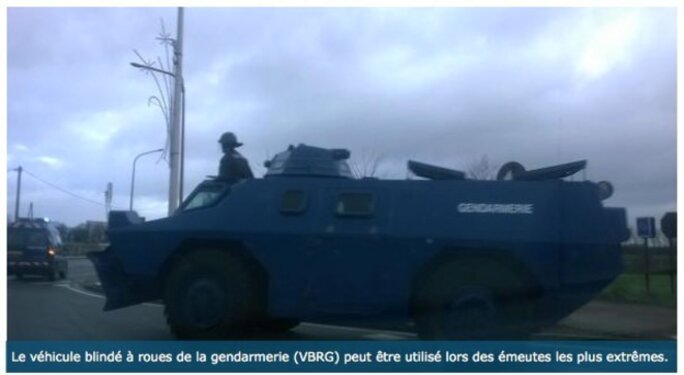
Enlargement : Illustration 9

It is true that the forces of law and order who regularly harass the camp are most certainly in danger from refugees who are distributed with one meal per day. Thankfully they can count on the help, when needed, of a few excited far-right supporters.
WE, THE UNITED PEOPLE OF THE JUNGLE OF CALAIS
A camp enclosed by a fence,watched over by CCTV cameras, access to which is controlled by biometric identification, built by a company whose boss is a former member of military intelligence, with no water supply, showers or kitchen, harassed by the police and far-right groups, backed up by three armoured vehicles.
That, in substance, is why the refugees are in no hurry to move into the so-called humanitarian camp, even though they are freezing with cold, struck down with illnesses and injuries from accidents while trying to cross into Britain, and are angry at France’s inhospitable policies.
Last week they published a text which says this: “We, the united people of the Jungle of Calais, decline the demands of the French government with regards to reducing the size of the Jungle. We have decided to remain where we are and will peacefully resist the government’s plans to destroy our homes. We plead with the French authorities and the international communities that you understand our situation and respect our fundamental human rights.”
In face of this urgent situation, demonstrations of solidarity are being organised on January 23rd and 30th (see more here). For those wishing to join them from the Paris region, special coaches are made available for January 23rd (see more here).
-------------------------
- The original French version of this article by La Parisienne Libérée can be found on her blog here.
English version by Sue Landau and Graham Tearse


